
The unspotted saw-whet owl is a small "typical owl" in subfamily Surniinae. It is found in Costa Rica, El Salvador, Guatemala, Mexico, and Panama.
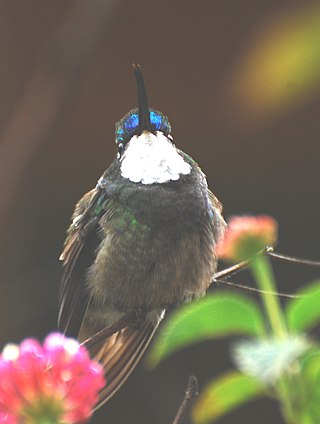
The grey-tailed mountaingem, also variously spelled gray-tailed mountaingem, grey-tailed mountain-gem, or gray-tailed mountain-gem, is a species of hummingbird in tribe Lampornithini of subfamily Trochilinae. It is endemic to Costa Rica.

The bronze-tailed plumeleteer is a species of hummingbird in the "emeralds", tribe Trochilini of subfamily Trochilinae. It is found in Colombia, Costa Rica, Ecuador, Nicaragua, and Panama.

The grey-headed dove (Leptotila plumbeiceps) is a large New World dove. It is found from eastern Mexico to Colombia.

The gorgeted puffleg is a Critically Endangered species of hummingbird in the "brilliants", tribe Heliantheini in subfamily Lesbiinae. It is endemic to Colombia. It was discovered in 2005 and confirmed as a species new to science in 2007.

The wine-throated hummingbird is a species of hummingbird in tribe Mellisugini of subfamily Trochilinae, the "bee hummingbirds". It is found in El Salvador, Guatemala, Honduras, and Mexico.

The green-tailed emerald is a species of hummingbird in the "emeralds", tribe Trochilini of subfamily Trochilinae. It is endemic to Venezuela.

The rufous-vented ground cuckoo is a Vulnerable species of cuckoo in the tribe Neomorphini of subfamily Crotophaginae. It is found in Bolivia, Brazil, Colombia, Costa Rica, Ecuador, Nicaragua, Panama, and Peru.
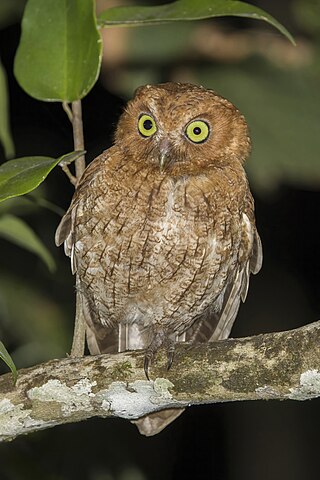
The Middle American screech owl, also known as the Guatemalan screech owl or the vermiculated screech owl, is a species of owl in the family Strigidae. It is found from northern Mexico to western Panama.

The Colombian crake is a species of bird in the subfamily Rallinae of the rail, crake, and coot family Rallidae. It is found in Colombia, Ecuador, and Panama.

The yellow-headed warbler is one of two species of bird in the Cuban warbler family Teretistridae. It is endemic to western Cuba.

The Cuban warblers are a genus, Teretistris, and family, Teretistridae, of birds endemic to Cuba and its surrounding cays. Until 2002 they were thought to be New World warblers, but DNA studies have shown that they are not closely related to that family. The family consists of two species, the yellow-headed warbler and the Oriente warbler. Both species are found in forest and scrub, with the yellow-headed warbler ranging in the west of the island and the Oriente warbler in the east. The Cuban warblers are 13 cm (5.1 in) long and have similar yellow and grey plumage.
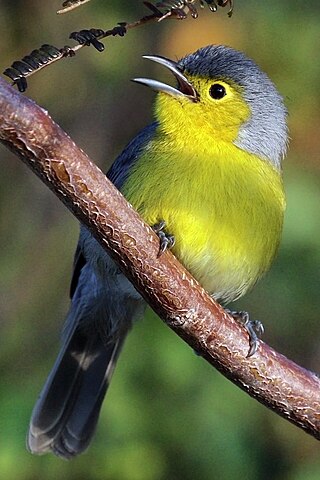
The Oriente warbler is one of two species of bird in the Cuban warbler family Teretistridae. It is endemic to central and eastern Cuba.

The spotted woodcreeper is a species of bird in the subfamily Dendrocolaptinae of the ovenbird family Furnariidae. It is found in Belize, Colombia, Costa Rica, Ecuador, El Salvador, Guatemala, Honduras, Mexico, Nicaragua, and Panama.

The stripe-billed aracari or stripe-billed araçari is a near-passerine bird in the toucan family Ramphastidae. It is found in Colombia, Ecuador, and Panama.

The gartered trogon, also known as the northern violaceous trogon, is a bird in the family Trogonidae, the quetzals and trogons. It is found in Mexico, all of Central America, and Colombia, Ecuador, Peru, and Venezuela.
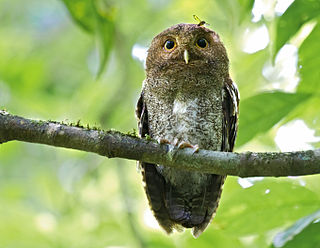
The vermiculated screech owl, is a subspecies of Middle American screech owl, or possibly separate species of owl in the family Strigidae. It is found in Costa Rica, Nicaragua, and Panama.
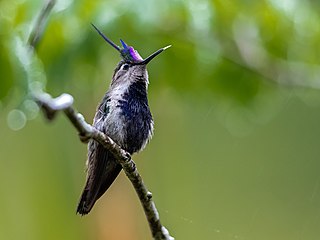
The purple-crowned plovercrest, or violet-crowned plovercrest, is a species of hummingbird in the "emeralds", tribe Trochilini of subfamily Trochilinae. It is found in Argentina, Brazil, and Paraguay.

The Ecuadorian rail is a species of bird according to the International Ornithological Committee (IOC), but other taxonomic systems treat it as a subspecies of the Virginia rail. It is in subfamily Rallinae of family Rallidae, the rails, gallinules, and coots. It is found in Colombia, Ecuador, and Peru.

The Talamanca hummingbird or admirable hummingbird is a species of hummingbird in the "mountain gems", tribe Lampornithini in subfamily Trochilinae. It is found in Costa Rica and Panama.























